用户交互Scanner
Scanner对象
-
之前我们学的基本语法中我们并没有实现程序和人的交互,但是Java给我们提供了这样一个工具类,我们可以获取用户的输入。java.util.Scanner是java5的新特性,我们可以通过Scanner类来获取用户的输入
-
调用Scanner类时ctrl点击Scanner可以进入他的类文件查看其它方法
-
基本语法:
Scanner s = new Scanner(System.in);
- 通过Scanner类的next()与nextLine()方法获取输入的字符串,在读取前我们一般需要使用hasNext()与hasNextLine()判断是否还有输入饿数据。
hasNext()与next()
next()
- 一定要读取到有效字符后才可以结束输入
- 对输入有效字符之前遇到的空白,next()方法会自动将其抹去
- 只有输入有效字符后才将其后输入的空白作为分隔符或者结束符
- next()不能得到带有空格的字符串
package com.shenxiaoyu.scanner;
import java.util.Scanner;
public class Demo001 {
public static void main(String[] args) {
//创建一个扫描器对象,用于接收键盘数据
Scanner scanner = new Scanner(System.in);//接收用户输入并封装成Scanner对象
System.out.println("请输入相关内容:");
//判断用户有没有输入字符串
if(scanner.hasNext()){
//使用next方法接收
String str = scanner.next();
System.out.println("输入的内容为:"+str);
}
scanner.close();//凡是属于IO流的类如果不关闭会一直占用资源,要养成好习惯用完就关掉
}
}
输出结果:

hasNextLine()与nextLine()
nextLine()
- 以Enter为结束符,也就是说nextLine()方法返回的是输入回车之前的所有字符
- 可以获得空格/空白
package com.shenxiaoyu.scanner;
import java.util.Scanner;
public class Demo002 {
public static void main(String[] args) {
//从键盘接收数据
Scanner scanner = new Scanner(System.in);
System.out.println("请输入相关内容:");
//判断是否还有输入
if(scanner.hasNextLine()){
//使用nextLine方法接收
String str = scanner.nextLine();
System.out.println("输入的内容为:"+str);
}
scanner.close();
}
}
输出结果:

不加if语句也可以实现输入输出,前面if语句是为了判断用户是否输入字符串
package com.shenxiaoyu.scanner;
import java.util.Scanner;
public class Demo003 {
public static void main(String[] args) {
Scanner scanner = new Scanner(System.in);
System.out.println("请输入相关内容:");
String str = scanner.nextLine();
System.out.println("输入的内容为:"+str);
scanner.close();
}
}
结果和刚才是一样的:
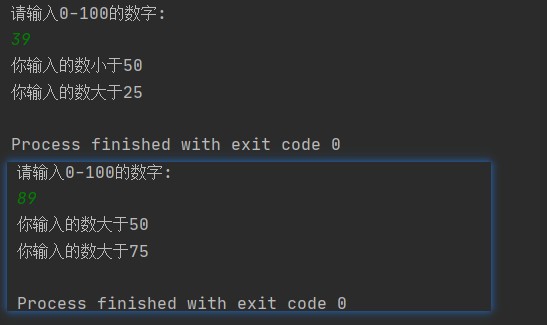
Scanner进阶用法
输入整型和浮点型
package com.shenxiaoyu.scanner;
import java.util.Scanner;
public class Demo004 {
public static void main(String[] args) {
Scanner scanner = new Scanner(System.in);
//从键盘接收数据
int i = 0;
float f = 0.0f;
System.out.println("请输入整数:");
if(scanner.hasNextInt()){
i = scanner.nextInt();
System.out.println("整数数据:"+i);
}else{
System.out.println("输入的不是整数数据!");
}
System.out.println("请输入小数:");
if(scanner.hasNextFloat()){
f = scanner.nextFloat();
System.out.println("小数数据:"+f);
}else{
System.out.println("输入的不是小数数据!");
}
scanner.close();
}
}
结果:
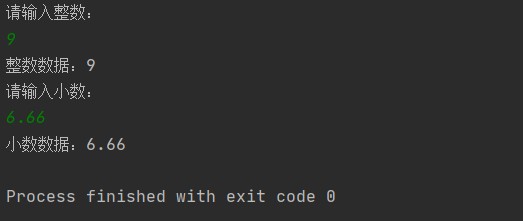
求和与平均数
package com.shenxiaoyu.scanner;
import java.util.Scanner;
public class Demo005 {
public static void main(String[] args) {
//我们可以输入多个数字,并求总和与平均数,每输入一个数字用回车确认,通过输入非数字来结束并输出执行结果:
Scanner scanner = new Scanner(System.in);
//和
double sum =0;
//计算输入了多少个数字
int m =0;
//通过循环判断是否还有输入,并在里面对每一个进行求和和统计
while(scanner.hasNextDouble()){
double x = scanner.nextDouble();
m++;//m+1
sum=sum+x;
System.out.println("你输入了第"+m+"个数据,然后当前结果sum="+sum);
}
System.out.println(m+"个数的和为:"+sum);
System.out.println(m+"个数的平均值为:"+(sum/m));
scanner.close();
}
}
结果为:
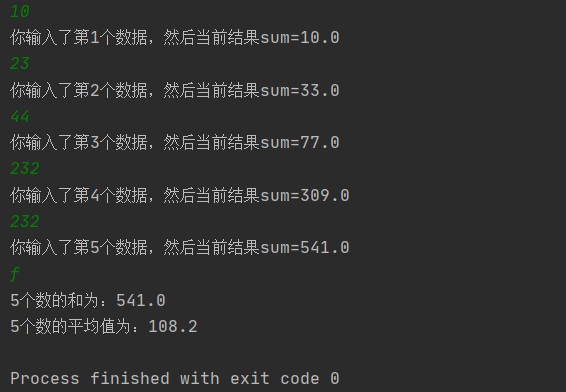
顺序结构
- JAVA的基本结构就是顺序结构,除非特别指明,否则,就按照顺序一句一句执行
- 顺序结构是最简单的算法结构
- 语句与语句之间,框与框之间是按从上到下的顺序进行的,它是由若干个依次执行的处理步骤组成的,它是任何一个算法都离不开的一种基本算法结构。

选择结构
if单选择结构
我们很多时候需要判断一个东西是否可行,然后我们才去执行,这样一个过程在程序中用if语句来表示
语法:
if(布尔表达式){
//如果布尔表达式为true将执行括号{}里的语句,否则将不执行
}
运用scanner练习if单选择结构:
package com.shenxiaoyu.struct;
import java.util.Scanner;
public class IfDemo01 {
public static void main(String[] args) {
Scanner scanner = new Scanner(System.in);
System.out.println("请输入内容:");
String s = scanner.nextLine();
//equals:判断字符串是否相等
if (s.equals("Hello")){
System.out.println(s);
}
System.out.println("End");
scanner.close();
}
}
结果:
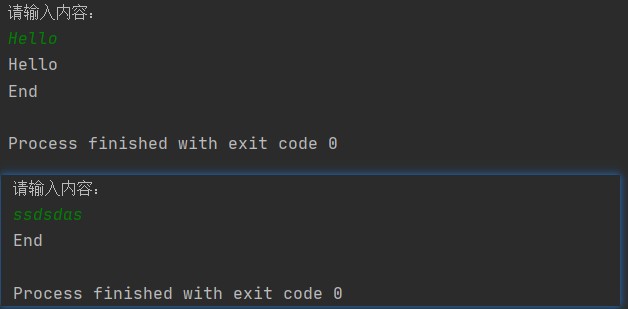
if-else双选择结构
那现在有个需求,成功了,我要A,失败了,我要B,这样的需求用一个if就搞不定了,我们需要有两个判断,需要一个双选择结构,所以有了if-else结构
语法:
if(布尔表达式){
//如果布尔表达式为true
}else{
//如果布尔表达式为false
}
运用scanner练习if-else双选择结构:
package com.shenxiaoyu.struct;
import java.util.Scanner;
public class IfDemo02 {
public static void main(String[] args) {
//考试分数大于60就是及格,小于60分就是不及格
Scanner scanner = new Scanner(System.in);
System.out.println("请输入成绩:");
int score = scanner.nextInt();
if(score>60){
System.out.println("及格");
}else{
System.out.println("不及格");
}
scanner.close();
}
}
结果:

if多选择结构
在生活中我们很多时候的选择不仅仅只有两个,所以我们需要一个多选择结构来处理这个问题
语法:
if(布尔表达式 1){
//如果布尔表达式 1的值为true执行代码
}else if(布尔表达式 2){
//如果布尔表达式 2的值为true执行代码
}else if(布尔表达式 3){
//如果布尔表达式 3的值为true执行代码
}....
else {
//如果以上布尔表达式都不为true执行代码
}
运用scanner练习if多选择结构:
package com.shenxiaoyu.struct;
import java.util.Scanner;
public class IfDemo03 {
public static void main(String[] args) {
Scanner scanner = new Scanner(System.in);
System.out.println("请输入成绩:");
int score = scanner.nextInt();
if(score==100){
System.out.println("恭喜满分");
}else if(score<100 && score>=90){
System.out.println("A级");
}else if(score<90 && score>=80){
System.out.println("B级");
}else if(score<80 && score>=70){
System.out.println("C级");
}else if(score<70 && score>=60){
System.out.println("D级");
}else if(score<60 && score>=0){
System.out.println("不及格");
}else {
System.out.println("成绩不合法");
}
scanner.close();
}
}
结果:
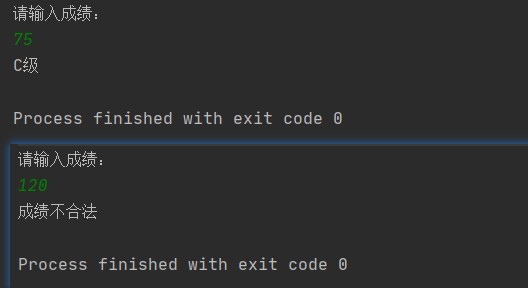
注意点:
- if语句至多有1个else语句,else语句在所有else if语句之后
- if语句可以有若干个else if语句,它们必须在else语句之前
- 一旦其中一个else if语句检测为true,其他的else if以及else语句都将跳过执行
嵌套的if结构
使用嵌套的if-else语句是合法的,也就是说你可以在另一个if或者else if语句中使用if或者else if语句。你可以像if语句一样嵌套else if....else
语法:
if(布尔表达式 1){
//如果布尔表达式 1的值为true执行代码
if(布尔表达式 2){
//如果布尔表达式 2的值为true执行代码
}
}
运用scanner练习嵌套的if结构:
package com.shenxiaoyu.struct;
import java.util.Scanner;
//查找输入0-100数的范围
public class IfDemo04 {
public static void main(String[] args) {
Scanner scanner = new Scanner(System.in);
System.out.println("请输入0-100的数字:");
int num = scanner.nextInt();
if(num<=100 && num>50){
System.out.println("你输入的数大于50");
if(num<=100 && num>75){
System.out.println("你输入的数大于75");
}else if (num==75){
System.out.println("你输入的数等于75");
}else{
System.out.println("你输入的数小于75");
}
}else if(num==50){
System.out.println("你输入的数等于50");
}else if(num<50&& num>=0){
System.out.println("你输入的数小于50");
if(num<50 && num>25){
System.out.println("你输入的数大于25");
}else if (num==25){
System.out.println("你输入的数等于25");
}else{
System.out.println("你输入的数小于25");
}
}else {
System.out.println("你输入的数不合法");
}
scanner.close();
}
}
结果:

switch多选择结构
- switch case 语句判断一个变量与一系列值中某个值是否相等,每个值都为一个分支
- switch语句中变量的类型可以是:
- byte,short,int或char
- 从javaSE 7开始,switch支持字符串String类型了
- 同时case标签必须为字符串常量或字面量
语法:
switch(expression){
case value:
//语句
break;//可选
case value:
//语句
break;//可选
//你可以有任意数量的case语句
default://可选
//语句
}
switch多选择结构语句char练习:
package com.shenxiaoyu.struct;
public class SwitchDemo01 {
public static void main(String[] args) {
//switch匹配一个具体的值
char grade = 'C';
switch (grade){
case 'A':
System.out.println("优秀");
break;
case 'B':
System.out.println("良好");
break;
case 'C':
System.out.println("及格");
break;
case 'D':
System.out.println("再接再厉");
break;
case 'E':
System.out.println("挂科");
break;
default:
System.out.println("未知等级");
}
}
}
结果:

switch多选择结构语句String练习:
package com.shenxiaoyu.struct;
public class SwitchDemo02 {
public static void main(String[] args) {
String name = "油炸蘑菇鱼";
switch(name){
case "沈小榆":
System.out.println("沈小榆是小可爱");
break;
case "油炸蘑菇鱼":
System.out.println("快来关注油炸蘑菇鱼");
break;
default:
System.out.println("弄啥嘞!");
}
}
}
结果:

循环结构
while循环
- while是最基本的循环,它的结构为:
while(布尔表达式){
//循环内容
}
- 只要布尔表达式为true,循环就会一直执行下去
- 我们大多情况是会让循环停止下来的,我们需要一个让表达式失效的方式来结束循环
- 少部分情况需要循环一直执行,比如服务器的请求响应监听等
- 循环条件一直为true就会造成无线循环【死循环】,我们正常业务编程中应该尽量避免死循环。会影响程序性能或者造成程序卡死奔溃!
while循环实现1~100总和
public class WhileDemo01 {
public static void main(String[] args) {
//输出1~100的和
int i =0;
int sum = 0;
while(i<=100){
sum=sum+i;
i++;
}
System.out.println(sum);//5050
}
}
do...while循环
- 对于while语句而言,如果不满足条件,则不进入循环,但有时候我们需要即使不满足条件,也至少执行一次。
- do-while循环和while循环相似,不同的是,do-while循环至少会执行一次
语法:
do{
//代码语句
}while(布尔表达式);
do-while循环实现1~100总和
public class DoWhileDemo {
public static void main(String[] args) {
int i=0;
int sum =0;
do{
sum=sum+i;
i++;
}while (i<=100);
System.out.println(sum);//5050
}
}
while和do-while的区别:
- while先判断后执行,do-while是先执行后判断
- do-while总是保证循环体会被至少执行一次!
public class DoWhileDemo01 {
public static void main(String[] args) {
int a = 0;
while(a<0){
System.out.println(a);
a++;
}
System.out.println("==============================");
do{
System.out.println(a);
a++;
}while(a<0);
}
}
从结果就能看出while和do-while的区别:

for循环
- 虽然所有循环结构都可以用while或者do-while表示,但java提供了for循环,使一些循环结构变得更加简单
- for循环语句支持迭代的一种通用结构,是最有效,最灵活的循环结构
- for循环执行的次数是在执行前就确定的
语法:
for(初始化;布尔表达式;更新){
//代码语句
}
快捷键:100.for+enter
while和for循环对比:
public class ForDemo01 {
public static void main(String[] args) {
int a = 1;//初始化条件
while(a<=100){//条件判断
System.out.println(a);//循环体
a+=2;//迭代
}
System.out.println("while循环结束!");
//初始化 条件判断 迭代
for(int i=1;i<=100;i++){
System.out.println(i);
}
System.out.println("for循环结束!");
}
}
for循环注意点:
- 最先执行初始化步骤。可以声明一种类型,但可以初始化一个或多个循环控制变量,也可以是空语句
- 然后,检测布尔表达式的值。如果为true,循环体被执行。如果为false,循环终止,开始执行循环体后面的语句
- 执行一次循环后,更新循环控制变量(迭代因子控制循环变量的增减)
- 再次检测布尔表达式,循环执行上面的过程
计算0到100之间的奇数和偶数和
public static void main(String[] args) {
//练习:计算0到100之间的奇数和偶数和
int oddSum = 0;
int evenSum = 0;
for (int i = 0; i <=100; i++) {
if(i%2!=0){
oddSum+=i;
}else{
evenSum+=i;
}
}
System.out.println("奇数和为:"+oddSum);//奇数和为:2500
System.out.println("偶数和为:"+evenSum);//偶数和为:2550
}
用while或for循环输出1~1000之间能被5整除的数,并且每行输出3个
public class ForDemo03 {
public static void main(String[] args) {
//练习:用while或for循环输出1~1000之间能被5整除的数,并且每行输出3个
for (int i = 0; i <=1000; i++) {
if (i%5==0){
System.out.print(i+" ");
}
//每行输出3个
if(i%(5*3)==0){
System.out.println();//System.out.print("
");
}
}
//println 输出完会换行
//print 输出完不会换行
}
}
打印九九乘法表
public class ForDemo04 {
public static void main(String[] args) {
for (int i = 1; i <=9; i++) {
//j<=i用来排除重复项
for (int j =1; j <=i; j++) {
System.out.print(i+"*"+j+"="+(i*j)+" ");
}
System.out.println();
/*
1*1=1
2*1=2 2*2=4
3*1=3 3*2=6 3*3=9
4*1=4 4*2=8 4*3=12 4*4=16
5*1=5 5*2=10 5*3=15 5*4=20 5*5=25
6*1=6 6*2=12 6*3=18 6*4=24 6*5=30 6*6=36
7*1=7 7*2=14 7*3=21 7*4=28 7*5=35 7*6=42 7*7=49
8*1=8 8*2=16 8*3=24 8*4=32 8*5=40 8*6=48 8*7=56 8*8=64
9*1=9 9*2=18 9*3=27 9*4=36 9*5=45 9*6=54 9*7=63 9*8=72 9*9=81
*/
}
}
}
增强型for循环
- java5引入了一种主要用于数组或者集合的增强型for循环
java增强for循环语法格式如下:
for(声明语句:表达式){
//代码句子
}
- 声明语句:声明新的局部变量,该变量的类型必须和数组元素的类型匹配。其作用域限定在循环语句块,其值与此时数组元素的值相等
- 表达式:表达式是要访问的数组名,或者返回值为数组的方法
public class ForDemo05 {
public static void main(String[] args) {
int[] numbers = {10,20,30,40,50,60};//定义了一个数组
//遍历数组的元素
for(int x:numbers){
System.out.println(x);
}
System.out.println("=======================");
for (int i = 0; i < 5; i++) {
System.out.println(numbers[i]);
}
}
}
和for对比结果相同:

break & continue & goto
break
在任何循环语句的主体部分,均可用break控制循环的流程。break用于强行退出循环,不执行循环中剩余的语句。(break语句也在switch语句中使用)
用于强行跳出循环语句但后续语句还是会被执行
public class BreakDemo {
public static void main(String[] args) {
int i =0;
while(i<100){
i++;
System.out.println(i);
if (i==30){
break;
}
}
System.out.println("123我是测试");
}
}
结果:
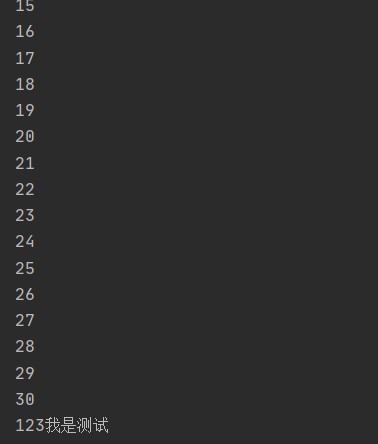
continue语句
在循环语句中,用于终止某次循环过程,即跳过循环体中尚未执行的语句,接着进行下一次是否执行循环的判定
用于结束当前循环,但还是会继续其他循环
public class ContinueDemo {
public static void main(String[] args) {
int i = 0;
while(i<100){
i++;
if(i%10==0){
System.out.println();
continue;
}
System.out.print(i);
}
}
}
结果:

关于goto关键字
- goto关键字很早就在程序设计语言中出现,尽管goto仍是java的一个保留字,但并未在语言中得到正式使用;java没有goto。然而,在break和continue这两个关键字的身上,我们仍然能看出一些goto的影子---带标签的break和continue
- “标签”是指后面跟一个冒号的标识符,例如:label:
- 对于java来说唯一用到标签的地方是在循环语句之前。而在循环之前设置标签的唯一理由是:我们希望在其中嵌套另一个循环,由于break和continue关键字通常只中断当前循环,但若随同标签使用,他就会中断存在标签的地方。
public class LabelDemo {
public static void main(String[] args) {
//打印101~150之间所有的质数
//质数就是指大于1的自然数中,除了1和它本身以外不再有其他因数的自然数
int count =0 ;
outer:for(int i=101;i<150;i++){
for(int j=2;j<i/2;j++){
if(i%j==0){
continue outer;//i%j==0则跳回到for循环标签标记处
}
}
System.out.print(i+" ");//101 103 107 109 113 127 131 137 139 149
}
}
}
拓展:打印三角形
public class TestDemo {
public static void main(String[] args) {
//打印三角形 5行
for (int i = 1; i <= 5; i++) {
for (int j = 5; j >=i; j--) {
System.out.print(" ");
}
for (int j = 1; j <=i; j++) {
System.out.print("*");
}
for (int j = 1; j <i; j++) {
System.out.print("*");
}
System.out.println();
/*
*
***
*****
*******
*********
*/
}
}
}